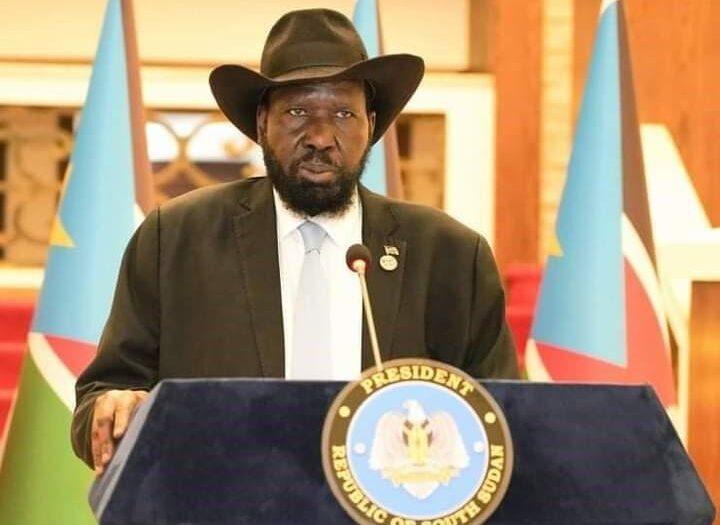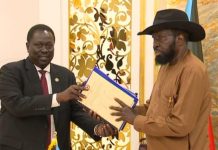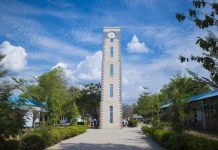Africa-Press – South-Sudan. First and foremost, I congratulate you Mr. President for keeping a firm focus on consolidating peace in the country and holding the Revitalised Agreement on the Resolution of Conflict in South Sudan (R-ARCSS) since its signature by the parties in 2018 in Khartoum, Sudan. This agreement has calmed hostilities and military confrontation among the forces of rivaling parties. Keep this peace up to the successful conclusion, culminating in the first democratic and fair elections envisaged in the agreement.
To be straight to the point, your Excellency, we the citizens of this country feel comfortable talking to you directly sometimes in matters of high concern. We may not reach you physically in your office since you are a leader of millions of South Sudanese. But, some of us can reach you through the media to share with you the opinions we think are crucial to be brought into your full attention. I am writing this letter about the change of the University of Northern Bahr El Ghazal to be a “polytechnic” contrary to its status was envisaged by the then President of the Republic of Sudan, Field Marshal, Omar Hassen Ahamed El Bashir in 2010. The Minister of Higher Education announced few weeks ago that the University of Northern Bahr El Ghazal shall operate as a polytechnic institution offering courses such in health sciences. Mr. President, this idea is unpopular among the citizens of Northern Bahr El Ghazal. Let the institution remain as the University of Northern Bahr El Ghazal as originally planned. Changing it would be unacceptable. Although there have been no funds to construct the university according to international standards, the communities of Aweil has been contributing whatever they have for the establishment of the institution. There is no single University in Northern Bahr El Ghazal despite its population compared to Rumbek and Bor where Rumbek and John Garang universities are based. I would like you to intervene by issuing a presidential order to maintain the university as planned. If not that way, then instruct the Ministry of Higher Education to table this matter in the Council of Ministers for discussion.
Three decades down the line
It is 28 years down the line since the idea of establishing a university in Northern Bahr el Ghazal was first conceived. In 1992, a group of eminent politicians, with backing of the citizens from Aweil, established a committee to lobby with the Government in Khartoum to establish a public university in Aweil. In 2005 (13 years later), the Khartoum Government, in the person of the then Vice President, Prof. Moses Machar, made a pledge to establish a public university in Aweil. In 2006, the President of the Government of South Sudan (GOSS), Lt. Gen, Salva Kiir, echoed the same pledge in a visit to Aweil. In May 2010, through a Presidential decree no.99, the University of Northern Bahr el Ghazal (UoNBeG) was established and a Vice Chancellor was appointed.
In June 2010, the establishment of the university was ratified through the University ACT 2010, bringing alongside it other public universities such as Dr. John Garang University of Science and Technology (Bor), Rumbek University, University of Yambio, and the University of Torit. A few years later, the then Minister of Higher Education publicly admitted that the Government of South Sudan did not have enough funds to operationalise the newly established universities and that the local respective communities would find their own way forward. The university’s mission is to contribute to skilled human capital in areas of strategic, economic, and security importance to the nation; to bring development to the local communities; to fight climate change, and to help the government meet the challenges of globalisation of our economies. The university’s goals ranged from establishing a research-based and research-driven institution, contributing to the achievement of Millennium Development Goals (MDGs), providing market-oriented educational programmes, to helping revitalize local industry and local business enterprises.
At its establishment, the university had its main office in Arkaweet, Khartoum and a coordination office at Mathiang, Aweil. Four main faculties were established:
Faculty of Architecture and Physical Planning (later moved to Yambio University)
Faculty of Petroleum Engineering and Earth Sciences (later taken to Bentiu University)
Faculty of Health Sciences and Medical Technology
Faculty of Preparatory, Human Resource Development, and Vocational Studies
An information handbook was written in 2012 as an information source for the university.
Needs in tertiary education
The educational needs in Northern Bahr el Ghazal state are immense and dire. According to the 2008 census, there are 720,898 (348,290 males, 372,608 females) people in NBeG. In 2011, there were 18 secondary schools in the whole of NBeG, a double-figure from the only 9 secondary schools in the state in 2009. In 2016-2017, the number of secondary schools in the state increased to 30, implying that more people have graduated from secondary schools and this further implies an ever-increasing need for higher institutions of learning. Every year, over 1,000 candidates sit for the South Sudan Secondary Certificate in the state. NBeG does not have a single functional public university; there are no proper private universities in the area either. Over the past few years, the number of students from Aweil who are admitted in other public universities in the country has dwindled. For instance, in the 2020 admission at Juba University, out of the 26,000 newly admitted students, only 272 (242 males, 30 females) of them were from NBeG state. With this small number of high school graduates making it to the university, the following questions forcefully come to light: What is happening to the rest of the high school graduates? What is stopping them from joining the university? Could it be fact that there is no higher institution of learning in the state be a hindrance to their desire to further their studies? Could the cost of living and studying outside the state be too expensive for the families of the majority of the high school graduates?
What is happening on the ground?
The university was decreed into existence in May 2010 with the hope that it would open its door for admission with fully functional faculties the following year. However, time proved that it was just but another sweet dream. Here are a few facts about the university since it was conceived:
No formal learning has taken place at the university ever since it was established, save for short English course lessons and computer training that later came to a stop.
Two of the university’s faculties were later withdrawn by the Ministry of Higher Education and the approval awarded to Yambio (Architecture and Physical Planning) and Bentiu University (Petroleum Engineering and Earth Sciences).
It costs about SSP600,000 for the Ministry of Higher Education to develop and approve a departmental/faculty curriculum for a university; so far, only one departmental curriculum is approved by the Ministry for the university. However, the Aweil Graduates Association (AGA) has promised to pay for one more departmental curriculum.
The university website is mostly not visible in most search engines (Google, Explorer, Bing, etc.). This means it is hard to find any information about the university online. At this age of information technology, it is commonly said that “If something doesn’t exist online, it simply doesn’t exist anywhere.” It is also observed that the content of the university website is too old (last updated years back) or simply obsolete. Not information one can use.
The university office block at Mathiang is functional and now acts as the head office for the university. More so, the university has legally acquired a large piece of land at Udhaba, Nyalath area. This would serve as another wing/campus for the university in addition to the Mathiang campus where construction of the fence has started since 2021.
Conclusion
The goodwill and the desire to establish a public university in and for Northern Bahr el Ghazal has existed for close to three decades. However, over the years, there has been very little tangible action done towards this desire. It has remained as a good dream with little or no concrete steps to realise it. With the previous promises and show of support by the national governments (both in the old Sudan and South Sudan), hopes were high that the dream would come to fruition. There should be no negative campaigns to dismantle this initiative. Some people may think, why should the government institution be constructed by the community? It can be done. Now, 15,000,000SSP have been contributed by the counties that constitute Northern Bahr El Ghazal. We the people of Mading Aweil want our institution to remain as “University of Northern Bahr El Ghazal”. We rejected the Polytechnic issue unless it is established separately in Aweil. The campaign with a slogan “No University of Northern Bahr E Ghazal, No Votes” is no a hatred against you Mr. President, it is a frustration of the people to their leaders starting from those elected in 2010 and other politicians in and out of the government who may wish to contest any position in the forthcoming elections. Your government should address this matter for our people.
For More News And Analysis About South-Sudan Follow Africa-Press






